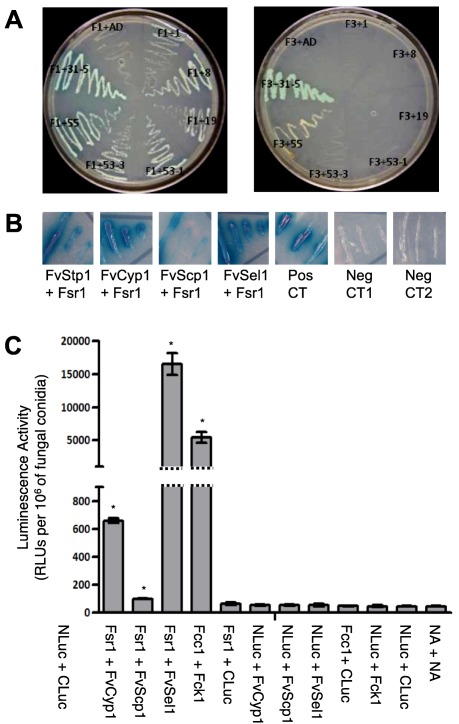Figure 3.

Identification of new Fsr1‐interacting proteins in F. verticillioides. (A) Bait F1 (N‐terminal Fsr1 with coiled coil motif) and Bait F3 (N‐terminal Fsr1 without coiled coil motif) were used for yeast‐two hybrid screening. Yeast strains bearing both the bait and prey plasmids were streaked on Synthetic defined medium without Ade‐His‐Leu‐Trp (Clontech) media amended with X‐alpha‐Gal. Prey strains, 1: HSP98, 8: SCP like extracellular protein, 19: Sel1 repeat protein, 53–1: Cyclophilin, 53–3: Cyclophilin, 55: Hex1, 31–5: Pex14. (B) Bait‐prey switch Y2H experiments were performed to verify performed interactions between Fsr1 and FvStp1 (positive control), FvCyp1, FvScp1, and FvSel1. The pair of plasmids pGBKT7–53 and pGADT7 was used as a positive control. The plasmid pairs pGBKT7‐Lam/pGADT7 (Neg CT1) and pGBKT7‐FSR1/pGADT7 (Neg CT2) were used as negative controls. (C) Further verification of in vivo interactions was tested by split luciferase complementation assay. Fcc1/Fck1 was used as positive control, and eight negative controls were tested (including no vector [NA]). Luminescence activity was obtained from three replicates of fungal inoculations and is presented as the number of RLUs (relative light units) per 106 of fungal conidia. Asterisk above the column means statistically significant (P<0.05) analyzed by t‐Test.
